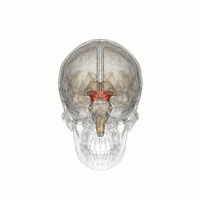Mesencephalic locomotor region
Mesencephalic Locomotor Region (MLR) is a region located in the midbrain that is crucial for initiating and controlling locomotion in mammals, including humans. The MLR has been extensively studied for its role in facilitating walking, running, and other forms of voluntary and involuntary movement. This area is of significant interest in neuroscience and neurology due to its implications in movement disorders and rehabilitation following neurological injuries.
Overview[edit | edit source]
The Mesencephalic Locomotor Region is situated in the upper part of the brainstem, specifically within the midbrain. It is involved in the initiation of locomotion and the control of its intensity. The MLR sends signals to lower brain regions that are responsible for the generation of movement patterns in the limbs. This region is interconnected with various parts of the brain, including the basal ganglia, cerebellum, and spinal cord, which are all critical in the coordination and execution of movement.
Function[edit | edit source]
The primary function of the MLR is to initiate and modulate locomotion. Activation of the MLR leads to the initiation of walking or running, depending on the intensity of the stimulation. The MLR achieves this by projecting to the reticular formation and the spinal cord, which in turn activate the motor neurons responsible for muscle contraction. The MLR is also involved in the adaptive control of locomotion, such as adjusting the speed and direction of movement.
Anatomy[edit | edit source]
The MLR is anatomically defined within the midbrain tegmentum. It encompasses areas such as the pedunculopontine nucleus (PPN) and the cuneiform nucleus. These nuclei are key components of the MLR and play a significant role in its locomotor functions. The PPN, in particular, has connections with the basal ganglia, which is known for its role in movement control, suggesting a complex network of brain regions involved in the regulation of locomotion.
Clinical Significance[edit | edit source]
The Mesencephalic Locomotor Region has been the focus of research in the context of movement disorders such as Parkinson's disease and spinal cord injury. Understanding the MLR's role in locomotion has implications for developing therapeutic strategies aimed at restoring mobility in individuals affected by these conditions. Deep brain stimulation (DBS) of the MLR and related structures has been explored as a potential treatment for improving gait and mobility in patients with Parkinson's disease.
Research and Future Directions[edit | edit source]
Research on the MLR continues to uncover its complexities and the mechanisms through which it controls locomotion. Advances in neuroimaging and neurophysiological techniques have provided insights into the functional organization of the MLR and its interactions with other parts of the brain. Future research aims to further elucidate the role of the MLR in locomotion and explore its potential as a target for therapeutic interventions in movement disorders.
Translate: - East Asian
中文,
日本,
한국어,
South Asian
हिन्दी,
தமிழ்,
తెలుగు,
Urdu,
ಕನ್ನಡ,
Southeast Asian
Indonesian,
Vietnamese,
Thai,
မြန်မာဘာသာ,
বাংলা
European
español,
Deutsch,
français,
Greek,
português do Brasil,
polski,
română,
русский,
Nederlands,
norsk,
svenska,
suomi,
Italian
Middle Eastern & African
عربى,
Turkish,
Persian,
Hebrew,
Afrikaans,
isiZulu,
Kiswahili,
Other
Bulgarian,
Hungarian,
Czech,
Swedish,
മലയാളം,
मराठी,
ਪੰਜਾਬੀ,
ગુજરાતી,
Portuguese,
Ukrainian
Navigation: Wellness - Encyclopedia - Health topics - Disease Index - Drugs - World Directory - Gray's Anatomy - Keto diet - Recipes
Search WikiMD
Ad.Tired of being Overweight? Try W8MD's physician weight loss program.
Semaglutide (Ozempic / Wegovy and Tirzepatide (Mounjaro / Zepbound) available.
Advertise on WikiMD
WikiMD is not a substitute for professional medical advice. See full disclaimer.
Credits:Most images are courtesy of Wikimedia commons, and templates Wikipedia, licensed under CC BY SA or similar.Contributors: Prab R. Tumpati, MD

